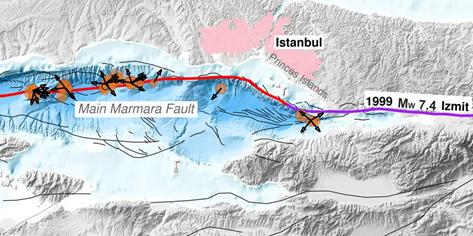A new analysis of earthquake rupture directivity provides essential insights for seismic hazard and risk assessments in urban areas, particularly concerning the Main Marmara Fault near Istanbul in western Türkiye. Based on the correlation between rupture directivity and the direction of the transported seismic energy, a team of researchers led by Dr Xiang Cheng and Prof. Patricia Martínez-Garzón from the GFZ Helmholtz Centre for Geosciences in Potsdam, Germany, has shown that quakes in the Marmara region transport a particularly large amount of energy and thus destructive force in the direction of Istanbul. Their study has been published in the journal Geophysical Research Letters. They analysed 31 well-constrained ML ≥ 3.5 earthquakes in this region. The unveiled critical patterns could influence preparedness for future seismic events in one of the world’s most populous cities.

Analyses in the Sea of Marmara based on smaller earthquakes and modelling
A team of researchers led by Dr Xiang Cheng and Prof. Patricia Martínez-Garzón of the GFZ Helmholtz Centre for Geosciences in Potsdam, Germany, investigated such directional effects in a new study. They analysed 31 well-constrained earthquakes of magnitude ML > 3.5 in the Sea of Marmara, west of the Istanbul megacity. Smaller earthquakes occur more often and can thus be studied in greater details, being a blueprint for ‘big ones’ that occur more rarely but with bigger implications.
In their study, the research team compared modelled and measured waveforms to calculate source mechanisms and then measured the earthquake durations at different directions to estimate directivity effects of moderate earthquakes in the Istanbul-Marmara region.
Findings: Increased transport of seismic energy in the direction of Istanbul
The findings reveal that most of the studied earthquakes below the Sea of Marmara west of Istanbul exhibit a predominantly eastward rupture. This results in more energy directed toward the metropolis. The median directivity trends at 85° from the North, aligning closely with the strike of the Main Marmara Fault. “This directional tendency suggests that ground shaking is more pronounced in Istanbul during such seismic events,” says Dr Xiang Chen, first author of the study and post-doc scientist at GFZ during the study.
Impact of the findings on potential stronger earthquakes in the Istanbul region
This information is particularly vital given that the Main Marmara Fault is considered to be late in its seismic cycle, meaning that a large earthquake is overdue. The present study does not reduce concerns about the implications of a large earthquake in the region: “Depending on where a future large earthquake would nucleate, these asymmetric rupture patterns could lead to heightened ground motion towards the urban centre of Istanbul,” states Prof. Patricia Martínez-Garzón, working group leader at GFZ Section 4.2 “Geomechanics and Scientific Drilling” and corresponding author of the study.
Consideration recommended for seismic hazard maps
When estimating seismic hazard maps for certain regions, rupture directivity, e.g. the preferential direction in which earthquakes radiate their energy, is not yet taken into account. “We want and plan to include directivity effects in the next generation of seismic hazard maps used in earthquake engineering, and results such as these are fundamental to enabling this development,” says Prof. Fabrice Cotton, co-author of the study and Head of GFZ-Section 2.6 “Seismic Hazard and Risk Dynamics”.
Source:
GFZ Helmholtz Centre for Geosciences
Provided by the IKCEST Disaster Risk Reduction Knowledge Service System
Comment list ( 0 )
